
A Locost is a home-built car inspired by the Lotus Seven. The car features a space frame chassis usually welded together from mild steel 1 in × 1 in square tubing. Front suspension is usually double wishbone with coil spring struts. The rear is traditionally live axle, but has many variants including independent rear suspension or De Dion tube. Body panels are usually fibreglass nose and wings and aluminium side panels. Each car is highly individualized according to the resources, needs and desires of each respective builder.

The Lotus Elite name has been used for two production vehicles and one concept vehicle developed and manufactured by British automobile manufacturer Lotus Cars. The first generation Elite Type 14 was produced from 1957 until 1963 and the second generation model from 1974 until 1982. The Elite name was also applied to a concept vehicle unveiled in 2010.

A hatchback is a car body configuration with a rear door that swings upward to provide access to the main interior of the car as a cargo area rather than just to a separated trunk. Hatchbacks may feature fold-down second-row seating, where the interior can be reconfigured to prioritize passenger or cargo volume.

The Fiat X1/9 is an Italian two-seater mid-engined sports car designed by Bertone and manufactured by Fiat from 1972–1982 and subsequently by Gruppo Bertone from 1982–1989.
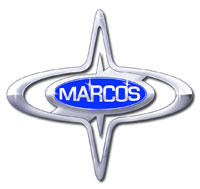
Marcos Engineering was a British sports car manufacturer. The name derives from the surnames of founders Jem Marsh and Frank Costin.
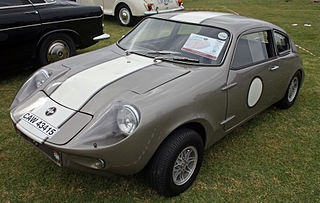
The Mini Marcos is an automobile produced in limited numbers between 1965 and 1970 by Marcos, from 1974 to 1981 by D & H Fibreglass Techniques Limited and again between 1991 and 1996 by Marcos. It was based on the DART design by Dizzy Addicott who finally sold the project to Jeremy Delmar-Morgan. Jeremy marketed the Mini DART as the Mini Jem. Jem Marsh of Marcos cars separately developed the project into the Mk I Mini Marcos and despite the similarity of the name, had nothing to do with the Mini Jem. In Sweden the Mini Marcos was sold by Elmhorn-Troberg Racing Service.
Sharps Commercials Ltd was a British car maker based in Preston, Lancashire. It was founded in 1922 by Paul Sharp. It changed its name to Bond Cars Ltd in 1963. The company was taken over by the Reliant Motor Co Ltd of Tamworth, Staffordshire in February 1969, who eventually closed the Preston factory at the end of July 1970, transferring the spare parts business for the Bond Minicar, 875 saloon, 875 Ranger van and Equipe models to a firm called Bob Joyner & Son in Oldbury in the English Midlands. Reliant nevertheless continued to use the Bond name until 1974 on Bond Bug models made at their own Tamworth plant.
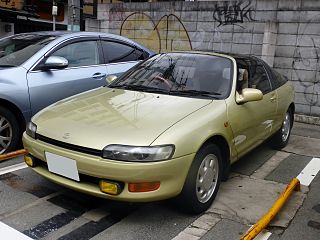
The Toyota Sera is a 3-door 2+2 hatchback coupe manufactured and marketed by Toyota from 1990 to 1996. It was only officially sold in Japan.

The Reliant Regal is a small three-wheeled car and van that was manufactured from 1952 to 1973 by the Reliant Motor Company in Tamworth, England, replacing the earlier Reliant Regent three-wheeled cyclecar van which had its origins in a design bought by Reliant from the Raleigh Bicycle Company. As a three-wheeled vehicle having a lightweight construction, under UK law it is considered a "tricycle" and can be driven on a full motorcycle licence. In 1962, with the release of the Reliant Regal 3/25, van and estate versions with a side-hinged rear door were marketed as the Reliant Supervan.

The Clan Crusader is a fibreglass monocoque British sports car based on running gear from the Hillman Imp Sport, including its Coventry Climax inspired, rear-mounted 875 cc engine. It was first made in Washington, Co Durham, England between 1971 and 1974, but since then several efforts have been made to bring the car back to production. Plans were made by Martin Phaff to re-resurrect the Clan in 2009, but nothing seems to have come of the project so far.

Banham Conversions was a coachbuilder and manufacturer of kit cars from the late 1970s until 2004. The company, based in Rochester, Kent, was founded by Paul Banham and started off as a coachbuilder, converting vehicles into convertibles. The company built convertible versions of high-end vehicles such as the Ferrari 400, Aston Martin DBS and V8, and the Rolls-Royce Corniche during this time.

The GTM Coupé is a Mini based kit car dating back to 1967. GTM is an initialism for "Grand Touring Mini". The car was first shown at the 1967 Racing Car Show and soon afterwards went into production by the Cox brothers from their garage in Hazel Grove, Stockport as the Cox GTM. In 1969 the rights to the design and manufacturing were bought by Howard Heerey and the Cox part of the name was dropped. Heerey's father's company, Midland Garage, took over manufacture of the GTM. In April 1980 ownership changed again to GTM Engineering, who upgraded and continued to manufacture the Coupé until 1995.
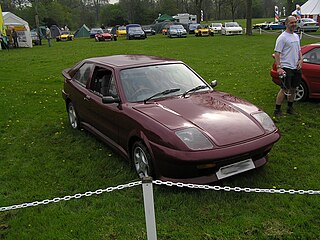
Quantum Sports Cars was founded by Mark and Harvey Wooldridge in 1987.
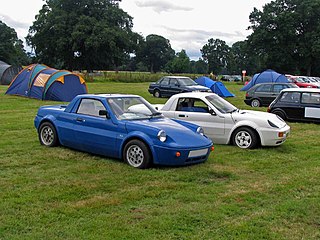
The GTM Rossa is a Mini based 2+2 kit car designed and sold by GTM Cars. It was styled by automotive designer Richard Oakes. The car was based on two front mini subframes attached to a central fibreglass monocoque, with the steering being locked on the rear subframe. The hard top roof was removeable and a soft top arrangement was available as an option from GTM. The Mark 1 car was produced from 1987 to 1990, and the Mark 2 car was produced beginning in 1990.

Eagle Cars Limited was an English company, based in Lancing, West Sussex, originally operated by Allen Breeze, although it has undergone a number of ownership changes since. Originally making a Jeep lookalike called the RV, between 1981 and 1998 they built several iterations of a gull-winged car called the Eagle SS. The SS was based on an American kit car called the Cimbria, and was brought to the UK by Tim Dutton. In 1988 Eagle Cars moved inland, to nearby Storrington.

The Bond Bug is a small British two-seat, three-wheeled automobile which was designed by Tom Karen of Ogle Design for Reliant Motor Company, who built it from 1970 to 1974, initially at Bond Cars Ltd factory, but subsequently at Reliant's Tamworth factory. It is a wedge-shaped microcar, with a lift-up canopy and side screens instead of conventional doors.
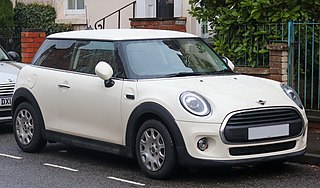
The Mini supermini range, marketed under various names such as Mini Cooper, Mini Hatch, Mini Hardtop, Mini One, and Mini John Cooper Works, are a family of retro-styled three-door hatchback, two-door convertible, and five-door hatchback. The range was introduced in July 2001, following the acquisition of the Mini brand by German automaker BMW.
Minari Engineering Ltd. was a Limited company based in Staffordshire, UK. They manufactured two vehicles, the Minari Club Sport, and the Minari Road Sport. They specialised in producing the components required to build cars based upon the Alfa Romeo Alfasud and 33 running gear, with bodies mainly constructed from GRP. These could either be purchased in Kit form or through a build agent, Chameleon Cars. Around 130 Mk2 kits were sold before production finally stopped in 2000.

New Zealand had a long history of small garages and vehicle enthusiasts modifying and creating sports and sports racing cars. Out of these interests grew the New Zealand kit and replica car industry with the introduction of fibre-glass car bodies in the 1950s.


















